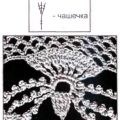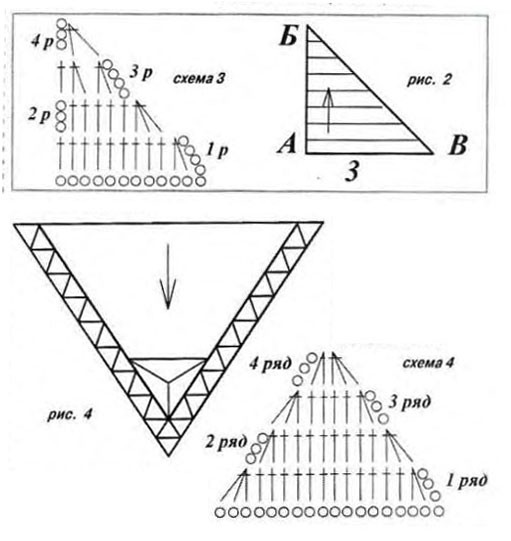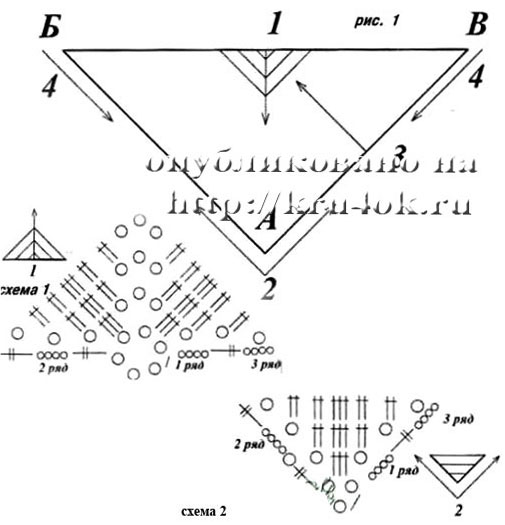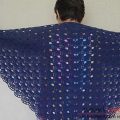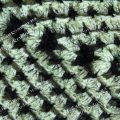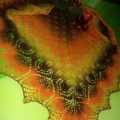
Knitting crochet shawls
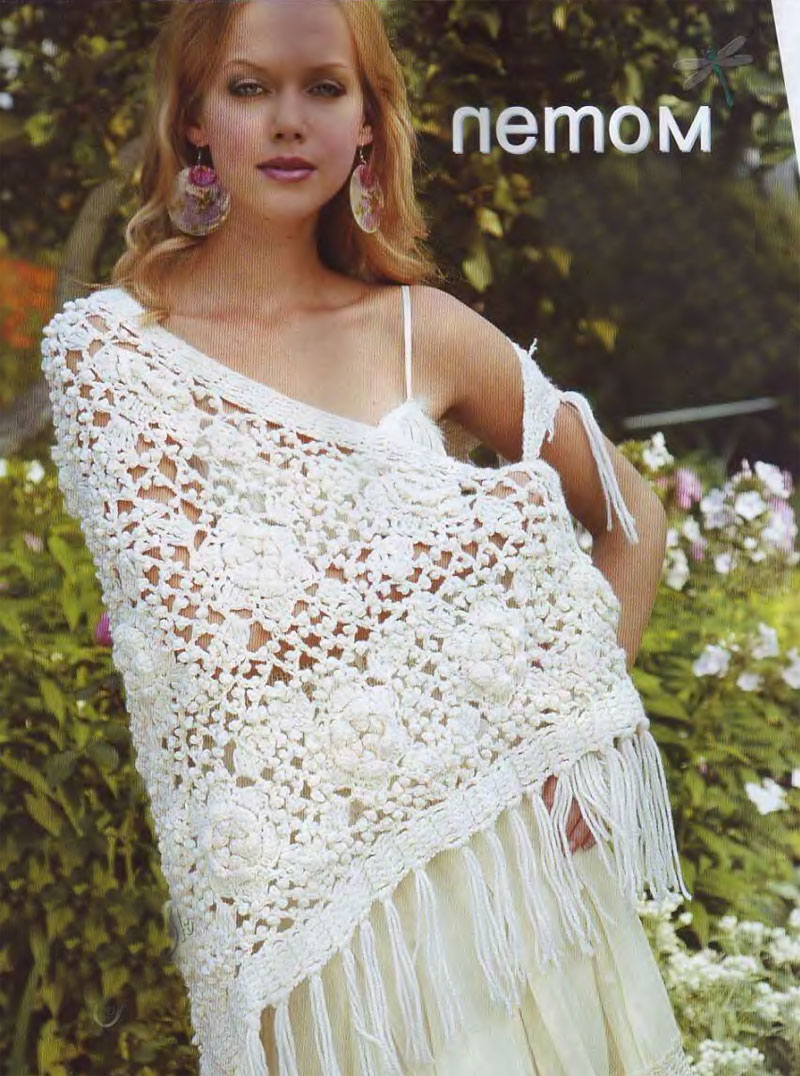 Shalju in Russia traditionally called the bigA rectangular scarf made of fine woolen fabric with a flower border or ornament. Today - a woven or knitted cloth of a large size of different shapes: a rectangle, a square, a triangle. For knitting shawls you will need 700 g of wool yarn and hook No. 3. The canvas shawl consists of separate square motifs in the center of which there is a three-dimensional flower. Link the motives according to the scheme, connecting them together in the last row for the "pico". Tie the finished fabric along the perimeter with a braid of 5 stitches with a crochet. Make the brush.
Shalju in Russia traditionally called the bigA rectangular scarf made of fine woolen fabric with a flower border or ornament. Today - a woven or knitted cloth of a large size of different shapes: a rectangle, a square, a triangle. For knitting shawls you will need 700 g of wool yarn and hook No. 3. The canvas shawl consists of separate square motifs in the center of which there is a three-dimensional flower. Link the motives according to the scheme, connecting them together in the last row for the "pico". Tie the finished fabric along the perimeter with a braid of 5 stitches with a crochet. Make the brush. 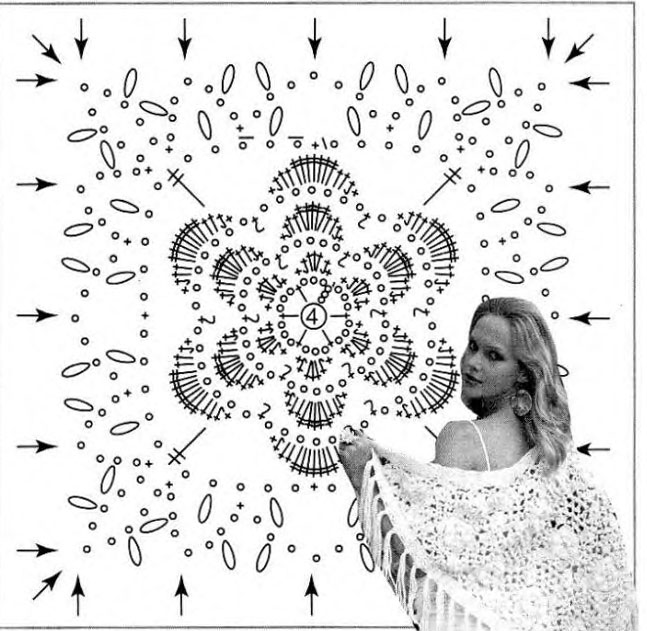 A bit of the history of shawls. At the turn of the XVII-XX centuries, shawls made of wool of kashmina - a podpushka of high-mountain goats - were fashion. They began to be produced in Kashmir from the 15th century. In Europe, they fell due to the colonialists - the British. France went its own way Napoleon Bonaparte, paying much attention to the development of the textile industry, banned the importation of goods from England. Therefore, shawls appeared in France only after the "Egyptian" campaigns of the emperor. Later, his economist Terno established the production of shawls in France. They were superior to the Kashmiri elegance of the design, the fineness of the workings. Fashion for shawls was not accidental. They perfectly complemented fashionable at the time dresses in the style of "Empire" from the finest muslin with an overstated waist, a large neckline, with short sleeves, which suited little for countries with a cold climate. Fashion women, imitating the costumes of ancient Greek women, were frozen in them, ached and died. Doctors asked to cancel the fashion that caused such a large death rate. But the ladies did not want to give up such seductive clothes, they found a way out - they began to bask with shawls. Large rectangular shawls were aesthetically attractive, lightly warm. They saved the freezing ladies in the cold season, decorated in the warm. Shawls were for different occasions: for going out into the light, for ballroom dances, for visits, for the house. Multicolored, with an elegant design of the canvas, they were the decoration of any outfit. Napoleon's beloved wife, Josephine, had 400 different shawls. In Russia, eastern shawls were first imported. But already at the very beginning of the XIX century local production was adjusted. The process of weaving was very laborious and lasting from one and a half to two years. Such shawls were only available to nobility of 10-12 thousand rubles were a fortune. To expand and cheaper production, new types of raw materials were sought. They became a thin goat down. Shawls, produced in the workshops of the landowner Kolokoltsov, were weaved without inverting by the method of bilateral weaving. The landlord Yeliseyeva was able to replace the wool of Tibetan goats with saiga wool. Such shawls cost 200 rubles - the annual salary of the worker factory that produces them. Cheaper Kupavin shawls, produced in the factories of Prince Yusupov, they were worn only by merchants. The ability to wear shawls paid much attention. There was a time when the ability to wear shawls was taught in women's educational institutions and graduates danced in front of high-ranking guests, demonstrating grace and grace. Very large shawls (in three human height) were worn, wrapping one end around the arm, the other descended to the ground. At the corners were sewn gold balls, which with their weight kept the shawl in the right position. Sometimes the balls wove in the brush. Source: magazine Mod.
A bit of the history of shawls. At the turn of the XVII-XX centuries, shawls made of wool of kashmina - a podpushka of high-mountain goats - were fashion. They began to be produced in Kashmir from the 15th century. In Europe, they fell due to the colonialists - the British. France went its own way Napoleon Bonaparte, paying much attention to the development of the textile industry, banned the importation of goods from England. Therefore, shawls appeared in France only after the "Egyptian" campaigns of the emperor. Later, his economist Terno established the production of shawls in France. They were superior to the Kashmiri elegance of the design, the fineness of the workings. Fashion for shawls was not accidental. They perfectly complemented fashionable at the time dresses in the style of "Empire" from the finest muslin with an overstated waist, a large neckline, with short sleeves, which suited little for countries with a cold climate. Fashion women, imitating the costumes of ancient Greek women, were frozen in them, ached and died. Doctors asked to cancel the fashion that caused such a large death rate. But the ladies did not want to give up such seductive clothes, they found a way out - they began to bask with shawls. Large rectangular shawls were aesthetically attractive, lightly warm. They saved the freezing ladies in the cold season, decorated in the warm. Shawls were for different occasions: for going out into the light, for ballroom dances, for visits, for the house. Multicolored, with an elegant design of the canvas, they were the decoration of any outfit. Napoleon's beloved wife, Josephine, had 400 different shawls. In Russia, eastern shawls were first imported. But already at the very beginning of the XIX century local production was adjusted. The process of weaving was very laborious and lasting from one and a half to two years. Such shawls were only available to nobility of 10-12 thousand rubles were a fortune. To expand and cheaper production, new types of raw materials were sought. They became a thin goat down. Shawls, produced in the workshops of the landowner Kolokoltsov, were weaved without inverting by the method of bilateral weaving. The landlord Yeliseyeva was able to replace the wool of Tibetan goats with saiga wool. Such shawls cost 200 rubles - the annual salary of the worker factory that produces them. Cheaper Kupavin shawls, produced in the factories of Prince Yusupov, they were worn only by merchants. The ability to wear shawls paid much attention. There was a time when the ability to wear shawls was taught in women's educational institutions and graduates danced in front of high-ranking guests, demonstrating grace and grace. Very large shawls (in three human height) were worn, wrapping one end around the arm, the other descended to the ground. At the corners were sewn gold balls, which with their weight kept the shawl in the right position. Sometimes the balls wove in the brush. Source: magazine Mod.

